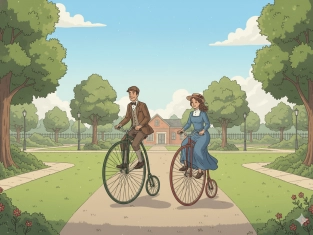Narrative Tenses – All Past Tenses
Table of Contents
Exercises
Explanation
The four narrative tenses are:
-
Past Simple
-
Past Continuous
-
Past Perfect
-
Past Perfect Continuous
Each tense plays a different role in building a clear and engaging narrative.
1. Past Simple
The Past Simple describes completed actions or events that took place at a definite moment in the past. It is also used to list events in chronological order.
Form
-
Affirmative: subject + V2
-
Negative: subject + didn’t + V1
-
Questions: Did + subject + V1?
Examples
-
Oliver closed the door and turned off the lights.
-
We didn’t catch the early train.
-
Did you enjoy the concert last night?
Use
-
A single, finished action
-
A sequence of actions
-
Repeated habits in the past
2. Past Continuous
The Past Continuous describes actions that were in progress at a particular past moment. It is also used to show background scenes or two actions happening at the same time.
Form: was / were + verb-ing
Examples
-
She was drawing when her friend knocked on the door.
-
The birds were singing while we were walking through the park.
-
It was getting dark outside.
Use
-
An action in progress at a specific time
-
Simultaneous actions
-
Descriptions of atmosphere or background
3. Past Perfect
The Past Perfect shows that one action was completed before another past action or moment. It helps create a clear time order.
Form: had + V3
Examples
-
I had closed all the windows before the storm started.
-
She had never visited the theatre before last month.
-
By the time we arrived, the meeting had finished.
Use
-
The earlier of two past events
-
Giving explanations or reasons for past situations
4. Past Perfect Continuous
The Past Perfect Continuous highlights the duration of an activity that was happening before another event in the past. It often explains visible or emotional results.
Form: had been + verb-ing
Examples
-
They had been walking for miles before they found the village.
-
He had been practising all morning when the coach arrived.
-
Her clothes were wet because she had been cycling in the rain.
Use
-
A long action before a shorter past event
-
Showing cause (tired, upset, dirty, etc.)
How Narrative Tenses Work Together in a Story
When telling a story, we typically combine all four tenses:
Past Simple → main events
Daniel entered the café and ordered a drink.
Past Continuous → background
Soft music was playing in the background.
Past Perfect → earlier events
He remembered that he had left his wallet at home.
Past Perfect Continuous → long earlier actions
He had been searching for it all morning.
Together, these tenses help us build clear, logical, and vivid descriptions of the past.
Quick Summary Table
|
Tense |
Use |
Example |
|
Past Simple |
Finished events |
She opened the letter. |
|
Past Continuous |
Background or interrupted actions |
She was reading when the doorbell rang. |
|
Past Perfect |
Earlier past action |
She had left before the show began. |
|
Past Perfect Continuous |
Long earlier action |
She had been studying all afternoon. |

